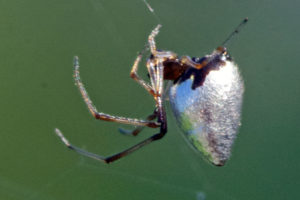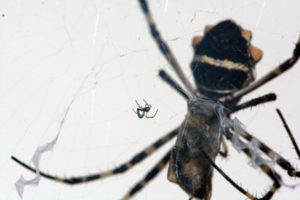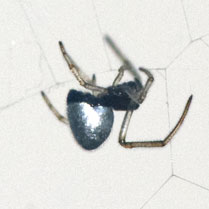A few months ago, I joined a Facebook group called Florida Entomology. It’s nice to see so many different pictures of insects and spiders and whatnot from around the state. And several of the people who post there are incredible photographers. One recent post caught my eye, because it captured the incredible beauty of a tiny spider that I see relatively frequently in my yard: a kleptoparasitic (food-stealing) spider in the complex Argyrodes/Faiditus/Neospintharus/Rhomphaea.
It was particularly interesting to me because just about 10 days earlier, I’d gotten my own first acceptable image of a dewdrop spider from my yard:

Just how small is it? Well, I have a particularly fine macro lens on my camera (this is my DSLR, not my phone), and I was about as close to the spider as I could get and still have it in focus (less than 20 inches). That means the image scale is as large as it can possibly be. If you click the image above, you’ll get a file 1496 pixels wide. It makes it look huge. It’s not. If that spider were next to a bee’s head, it would fit on the eyes. The one from Steve Long’s image (the Facebook post I referenced at the beginning of this post) is described as “one-third the size of a grain of rice.” The largest ones I’ve seen are no bigger than their namesake:1 dewdrops.
Spiders in this group live a particularly daring lifestyle: they live in the webs of larger spiders, eating the prey that its host doesn’t want or isn’t fast enough to get or vigilant enough in guarding. Marhsall and Edwards provide a good description of its behavior in Florida’s Fabulous Spiders:
This species [Argyrodes nephilae] enjoys the very great advantage of not having to produce or maintain its own web. It actually avoids the main web of the host spider, preferring to hang out on the frame and barrier web strands. Here it waits until wrapped prey is unattended by the host spider. Then it stealthily sneaks up to the prey, dragging a line behind it which is attached to the barrier web line. Once it attaches its own line, it cuts the thread from which the prey hangs. The prey then swings out into the barrier web. If the Argyrodes has done its job well, the host spider will never know it has been robbed. But if the Argyrodes nephilae makes a mistake, the bigger spider will come charging over to reclaim its prize.
Etymology
The spider discussed above specializes in living in the webs of one of our largest orbweavers, Nephila clavipes, about which I’m astonished to discover I’ve not written before on this site, except for in asides on other posts. I’ll be sure to rectify that soon. In any case, that large spider, I presume, is where the specific epithet (nephilae) of its tiny kleptoparasite comes from.
The genus name, Argyrodes, means “silvery.”
Speaking of silvery spiders, it’s worth pointing out that members of this silvery dewdrop spider group don’t live just with the yellow-silk orbweaver. They can also be found in the webs of the more common (in my yard) large orbweaver, the Silver Argiope (Argiope argentata), about which I’ve written in the past.
Here is a shot taken last year that shows both species, so you can get an idea of the enormous size disparity between them:

The image above also shows why I haven’t written about these little guys before: same lens, same photographer, different luck capturing an image of this little one. Here’s a crop from the above photo showing just the argyrid:

No reason to write a post about that!
Related Images:
- From Merriam-Webster: “one who is named after another or for whom another is named”

Hi there I’m from whangarei, New Zealand and have just come across this dew drop spider. We’ve never seen this spider ever before. I had to Google a picture of it.